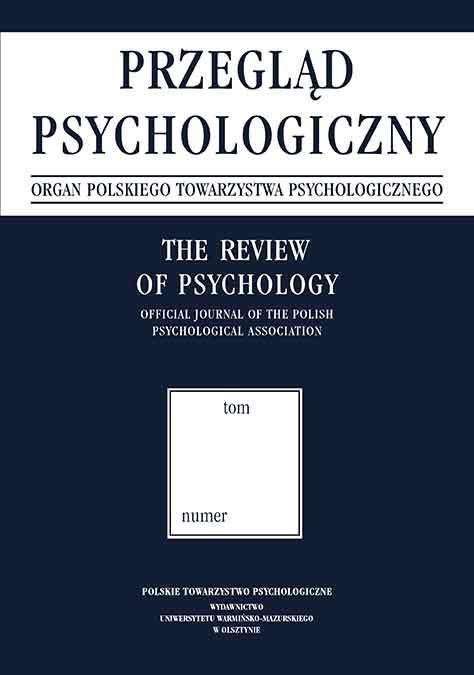Relationship of Phubbing to Self-Esteem in the Context of Perceived Phubbing Behavior of Parents
Bogumiła Weimann
University of Zielona Górahttps://orcid.org/0009-0004-8451-8380
Malwina Cholewa
https://orcid.org/0009-0000-4666-1865
Paweł Kleka
University of Zielona Górahttps://orcid.org/0000-0003-0841-0015
Abstrakt
Purpose: Phubbing is a phenomenon whereby a person looks at their mobile phone and uses it while talking to others, thereby avoiding interpersonal communication (Karadağ et al., 2015). The study aimed to investigate whether phubbing by parents correlates with phubbing by their adult children, whether phubbing by parents is associated with children's self-esteem (in adulthood) and whether children's self-esteem (in adulthood) is correlated with their level of phubbing.
Method: 107 people from Poland participated in the study. The authors used the Rosenberg Self-Esteem Scale (SES), the Generic Scale of Phubbing (GSP), and self-report questions to verify the level of phubbing used by the subjects' parents.
Results: The results showed a positive correlation (r = .37, p < .001) between parents' phubbing and children's phubbing, as well as between children's self-esteem and phubbing by parents (r = .37; p < .001) and between children's phubbing and their self-esteem (r = .46, p < .001).
Conclusion: The study confirms the modelling role of parental phubbing for the intensity of children's phubbing, but at the same time, it does not show a negative role in children's self- esteem. Furthermore, the positive correlation between children's phubbing and self-esteem contradicts previous results. Children's phubbing partially mediates the relationship between parents' phubbing and their self-esteem, which requires further research to understand this mechanism more fully.
Słowa kluczowe:
phubbing, phubber, self-esteem, parenting, smartphoneBibliografia
Al-Saggaf, Y., & O'Donnell, S. (2019). Phubbing: Perceptions, reasons behind, predictors, and impacts. Human Behavior and Emerging Technologies, 1(2) 132–140. http://dx.doi.org/10.1002/hbe2.137
Crossref
Google Scholar
Bandura, A. (2007). Teoria społecznego uczenia się [Social Learning Theory]. Wydawnictwo Naukowe PWN. Google Scholar
Beukeboom, C. J., & Pollmann, M. (2021). Partner phubbing: Why using your phone during interactions with your partner can be detrimental for your relationship. Computers in Human Behavior, 124, Article 106932. http://dx.doi.org/10.1016/j.chb.2021.106932
Crossref
Google Scholar
Chotpitayasunondh, V., & Douglas, K. M. (2018). Measuring Phone Snubbing Behavior: Development and Validation of the Generic Scale of Phubbing (GSP) and the Generic Scale of Being Phubbed (GSBP). Computers in Human Behavior, 88, 5–17. http://dx.doi.org/10.1016/j.chb.2018.06.020
Crossref
Google Scholar
Ivanova, A., Gorbaniuk, O., Błachnio, A., Przepiórka, A., Mraka, N., Polishchuk, V., & Gorbaniuk, J. (2020). Mobile Phone Addiction, Phubbing, and Depression Among Men and Women: A Moderated Mediation Analysis. The Psychiatric Quarterly, 91(3), 656–668. https://doi.org/10.1007/s11126-020-09723-8
Crossref
Google Scholar
Karadağ, E., Tosuntaş, Ş. B., Erzen, E., Duru, P., Bostan, N., Şahin, B. M., Çulha, İ., & Babadağ Savas, B. B. (2015). Determinants of phubbing, which is the sum of many virtual addictions: a structural equation model. Journal of Behavioral Addictions, 4(2), 60–74. https://doi.org/10.1556/2006.4.2015.005
Crossref
Google Scholar
Kowaluk-Romanek, M. (2019). Cyfrowe dzieciństwo. Nowe technologie a rozwój dziecka [Digital childhood. New technologies and child development]. Edukacja – Technika – Informatyka [Education – Technology – Information Technology], 27(1), 194–201. http://dx.doi.org/10.15584/eti.2019.1.25
Crossref
Google Scholar
Liu, R.-D., Wang, J., Gu, D., Ding, Y., Oei, T. P., Hong, W., Zhen, R., & Li, Y.-M. (2019). The Effect of Parental Phubbing on Teenager's Mobile Phone Dependency Behaviors: The Mediation Role of Subjective Norm and Dependency Intention. Psychology Research and Behavior Management, 12, 1059–1069. https://doi.org/10.2147%2FPRBM.S224133
Crossref
Google Scholar
Łaguna, M., Lachowicz-Tabaczek, K., & Dzwonkowska, I. (2007). Skala samooceny SES Morrisa Rosenberga – polska adaptacja metody [Morris Rosenberg's SES Self-Assessment Scale – Polish Adaptation of the Method]. Psychologia Społeczna [Social Psychology], 2(4), 164–176. https://www.researchgate.net/publication/285640590_Skala_Samooceny_SES_Morrisa_Rosenberga_-_polska_adaptacja_metody Google Scholar
Masten, A. S. (2001). Ordinary magic: Resilience processes in development. American Psychologist, 56(3), 227–238. https://doi.org/10.1037/0003- 066X.56.3.227
Crossref
Google Scholar
Wang, X., Gao, L., Yang, J., Zhao, F., & Wang, P. (2020). Parental Phubbing and Adolescents’ Depressive Symptoms: Self-Esteem and Perceived Social Support as Moderators. Journal of Youth and Adolescence, 49, 427–437. https://doi.org/10.1007/s10964-019-01185-x
Crossref
Google Scholar
Wojciszke, B. (2011). Psychologia społeczna [Social Psychology]. Wydawnictwo Naukowe Scholar. Google Scholar
Xie, X., Chen, W., Zhu, X., & He, D. (2019). Parents' phubbing increases Adolescents' Mobile phone addiction: Roles of parent-child attachment, deviant peers, and gender. Children and Youth Services Review, 105, Article 104426. https://psycnet.apa.org/doi/10.1016/j.childyouth.2019.104426
Crossref
Google Scholar
Xie, X., & Xie, J. (2020). Parental phubbing accelerates depression in late childhood and adolescence: A two-path model. Journal of Adolescence, 78, 43–52. https://doi.org/10.1016/j.adolescence.2019.12.004
Crossref
Google Scholar
Licencja

Utwór dostępny jest na licencji Creative Commons Uznanie autorstwa – Użycie niekomercyjne – Bez utworów zależnych 4.0 Międzynarodowe.

